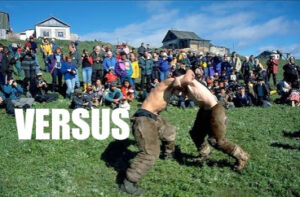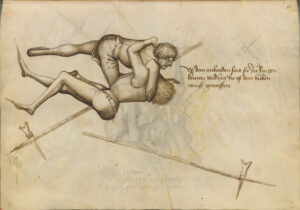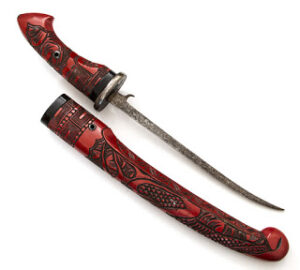Continuing in a medieval theme from the last post today I will write about a related topic, that of wrestling. If we look back at the history of wrestling we in fact see two related forms. The first form is the type that you are most likely familiar with, that of unarmed wrestling. Unarmed wrestling is common to many cultures. Many males, particularly the younger ones seem to have an inherent urge to compete. Numerous outlets for such feelings have been created, but one of the most common seems to have been wrestling. Wrestling was a non-lethal way for men to compete with their peers or neighbours, let off steam and establish pecking orders. Most varieties are designed so there is very little risk of serious injuries that might prevent an individual working and keeping his family fed. This is by no means restricted to humanity, of course. If we look at nature we see that most intra-species competitions between males are non-lethal, and many of them involve some test of strength such as head-butting or wrestling.

The second form of wrestling is more serious and is best described as “Battlefield Wrestling”. As personal body armour became more effective longer and/or heavier hand weapons were needed to penetrate it. The use of the horse in warfare determined that longer weapons were preferable so that both mounted and unmounted warrior could reach his enemy. But what happened if you weapon still failed to penetrate an enemy’s armour, or that the press of battle placed you so close to an enemy that neither of you could use your polearms to good effect. One answer to this common problem was battlefield grappling techniques. In both Japanese and European medieval warfare we have accounts of warriors throwing down their long weapons and grappling an armoured enemy. I’m sure that if I looked I would find the same tactics used in China, Korea, the middle east and other cultures that used body armour.

If an enemy is armoured many of the targets we would hit in normal combat are protected. Kicks and hand blows will mainly be used to unbalance a foe. Throws, and to a lesser extent locks will be used to get an enemy into a position from which he cannot defend himself. He can then be bound for ransom or interrogation or killed.
One still has the problem of penetrating that armour, and this was why the dagger was such an important part of a warrior’s equipment. In Europe battlefield daggers often had long, stiff but narrow blades. Often such blades were unedged and of triangular, square or diamond cross-section. A variety of designs such as the rondel and eared dagger were developed and it seems obvious that these were intended to facilitate an “ice-pick” hold and a powerful thrusting action. The long narrow blade could be slipped through the eyehole of a visor or slipped through a narrow gap between the plates or a weak point such as the armpit. A knight’s dagger is often called a “misericorde”, a word that means mercy. While one theory is that it got this name from being used to euthanize the badly wounded it is just as likely that this would be the plea of a grappled enemy who say the weapon about to be used.

In Japan the grappler’s primary weapon was the “yoroi doshi”. The was a straight or nearly straight double or single edged knife optimized for thrusting. Some are up to half an inch thick at the spine. The yoroi doshi was edged since taking an opponent’s head was a fundamental part of japanese warfare. While the name means “armour piercer” it was probably often slipped between plates or into the eye. The yoroi doshi was worn on the left side, edge upwards but some warriors realized the danger of being caught in a grappling situation and unable to reach their weapon, so carried multiple daggers. A variant of yori doshi was the metazashi with the fittings reversed so it was worn on the right. Other weapons might also be used in grappling. Kubizashi were sharp spikes used to label an enemy’s head. Since a samurai carried several of these they would have been used as weapons too. Weapons such as the hachiwara (a clubbing and parrying weapon) had a point that seems well suited for slipping between armoured plates. Supposedly the small hook on this weapon near the hilt could be used to lever back a helmet to break the neck, and this would probably be most practical if in a grappling situation.

That wrestling and grappling was a battlefield tactic explains why medieval fight manuals such as Talhoffer show some of his combatants holding daggers in his depictions of wrestling.